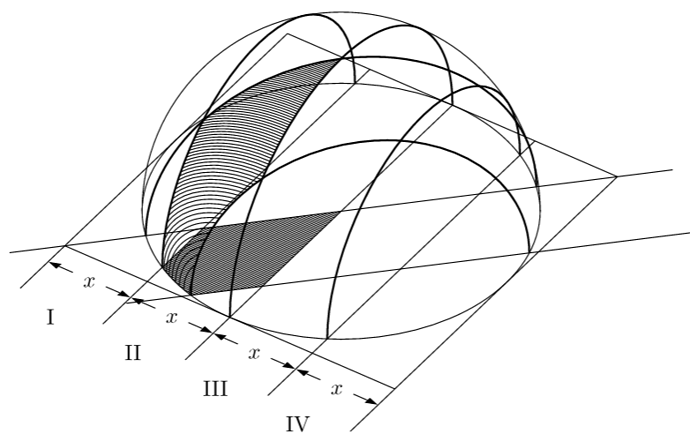In the end i managed to solve it by myself:
#import "@preview/cetz:0.3.1"
#let fsqrt=calc.sqrt
#cetz.canvas({
import cetz.draw: *
content=content.with(padding:0.5em)
set-style(
grid:(
stroke:gray,
),
mark: (
fill: black,
scale:0.5,
)
)
scale(175%)
on-xy({
arc((2,0), start: 0deg, stop: 180deg, radius:2, stroke:0.5pt)
})
let det=80
ortho({
on-xz({
set-style(
line: (stroke:0.5pt )
)
line((-2,2),(2,2))
line((-2,-2),(2,-2))
for i in range(4){
line((-1+i,2.8),(-1+i,-2))
content((-1.5+i,2.3),$x$)
line((-1.7+i,2.3), (-2+i,2.3), mark:(end:">"))
line((-1+i,2.3), (-1.3+i,2.3), mark:(start:">"))
content((-1.5+i,3),numbering("I", i+1))
}
line((-2,2.8),(-2,-2))
line((-2.4,2.4),(2.4,-2.4))
line((-2.4+fsqrt(2),2.4),(1.8+fsqrt(2),-1.8))
circle((0,0),radius:2,stroke:0.5pt)
for i in range(det){
let depth=2/det*i
let start=-calc.min(1,fsqrt(4-depth*depth))
let end=calc.min(0, -depth+fsqrt(2))
start=calc.max(start,-depth)
if start < end{
line((start,depth),(end,depth))
}
}
})
on-yz({
arc((fsqrt(3),0), start: 0deg, stop: 180deg, radius:fsqrt(3))
},x:-1)
on-yz({
arc((fsqrt(3),0), start: 0deg, stop: 180deg, radius:fsqrt(3))
},x:1)
on-yz({
arc((2,0), start: 0deg, stop: 180deg, radius:2)
})
rotate(y:-90deg)
for i in range(det){
let depth=2/det*i
on-yz({
let r=fsqrt(4-depth*depth)
let start=-calc.min(1,r)
let end=calc.min(0, -depth+fsqrt(2))
start=calc.max(start,-depth)
if start < end{
arc((-start,fsqrt(r*r - start*start)), start: calc.acos(-start/r), stop: calc.acos(-end/r), radius:r, stroke:0.5pt)
}
},x:depth)
}
rotate(y:45deg)
on-yz({
arc((2,0), start: 0deg, stop: 180deg, radius:2)
})
on-yz({
arc((fsqrt(3),0), start: 0deg, stop: 180deg, radius:fsqrt(3))
},x:1)
}, x:40deg, y:34deg)
})
@SillyFreak, thanks, i’ll update it asap.
